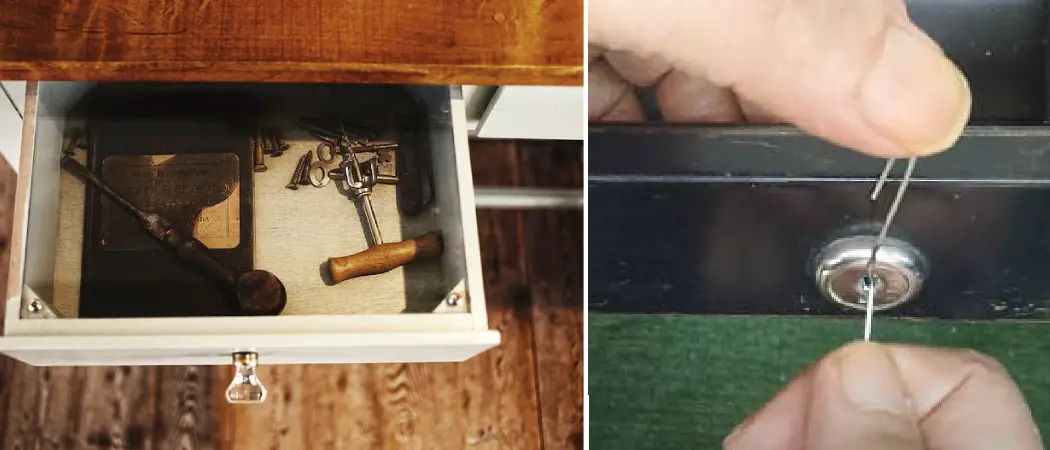Are you stuck outside your bedroom door, fiddling with a paper clip in an attempt to open the lock on your drawer? Don’t give up just yet! With some simple tricks and tips shared here, you can learn how to easily unlock any drawer locks using nothing but a paper clip.
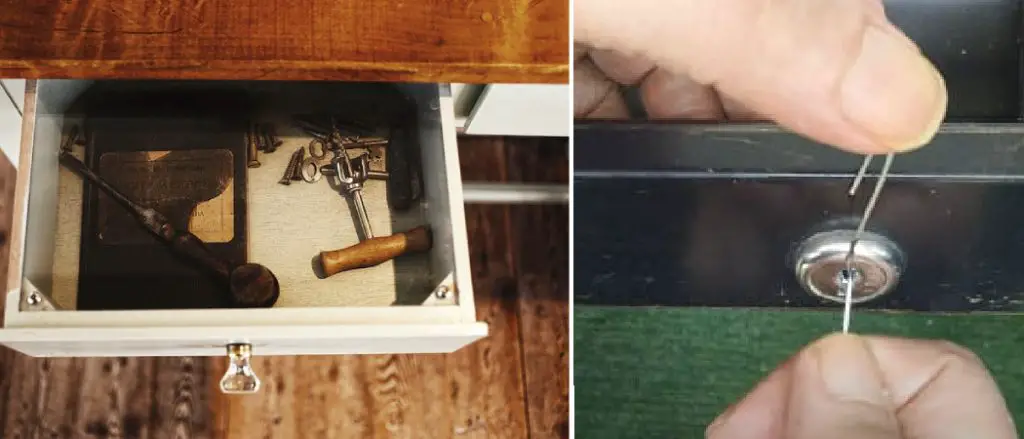
No longer will waiting for someone to come to rescue you from being locked out be necessary – now it’s possible for anyone with limited tools to gain access to their own drawers, and we’ll show you exactly how! Keep reading for our comprehensive guide on how to open drawer lock with paper clip.
Understanding the Basics of Drawer Locks
Before we delve into the process of unlocking a drawer, it’s important to understand the different types of locks and how they function.
A. Different Types of Drawer Locks and Their Mechanisms
- Pin Tumbler Locks: This is one of the most common types of locks. It consists of a series of pins with varying lengths. When the correct key is inserted into the lock, it aligns the pins, allowing the lock to open.
- Wafer Locks: These are similar to pin tumbler locks but instead use flat, single-piece wafers to prevent the lock from opening. The correct key aligns these wafers, allowing the lock to rotate.
- Tubular Locks: These are often found on bike locks or lock boxes. They have a circular keyway and a circular key to match, with the pins located all around the circumference of the lock.
B. Explanation of How These Locks Work
The basic principle of these locks is that they require the correct key to align all the internal components (pins for pin tumbler and tubular locks, wafers for wafer locks) to a specific position that allows the lock to rotate freely.
C. Legal and Ethical Considerations of Attempting to Open a Lock Without Permission
It’s important to note that using a paperclip to open a lock should only be done on locks you own or have permission to open. Attempting to pick a lock that isn’t yours or without the owner’s permission is illegal and unethical. Always respect others’ privacy and property.
Tools and Materials You’ll Need
Before you begin, make sure you have everything you need. Here’s a list of tools and materials that will come in handy:
- Paper clip (preferably a large one with some flexibility)
- Pliers or multi-tool (optional but recommended)
- Flashlight
Step-by-Step Guide How to Open Drawer Lock with Paper Clip
Step 1: Straighten Out the Paper Clip
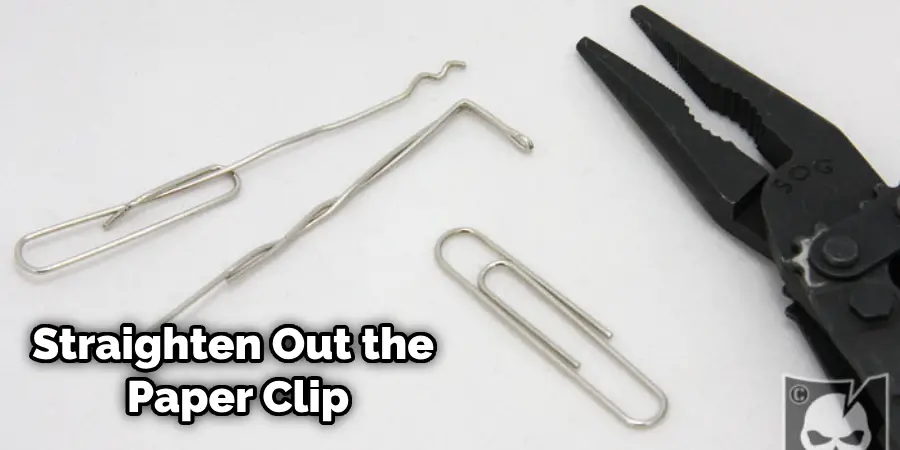
Start with a straightened paper clip, removing any bends or curves along its length. This will help give you better control and precision when picking the lock.
Step 2: Create a Hook at One End of the Paper Clip
Using pliers or your fingers, bend one end of the paper clip into a small hook shape. This will be used to push the pins or wafers in the lock.
Step 3: Insert the Hooked End of the Paper Clip into the Keyway
Gently insert the hooked end of the paper clip into the keyway (the opening where you would usually insert a key).
Step 4: Feel for Resistance and Identify Pin Placement
Slowly push the paper clip into the lock, paying attention to any resistance or obstacles. As you push in, try to feel for pins or wafers within the lock.
Step 5: Push Up on Pins or Wafers with the Hook
Once you have identified the pins or wafers, use your hook to push them up gently. It may take a few tries to find the right amount of pressure needed.
Step 6: Use a Flashlight for Better Visibility
If you’re struggling to see or feel inside the lock, use a flashlight to illuminate the keyway. This will make it easier to identify and manipulate the pins or wafers.
Step 7: Rotate the Lock
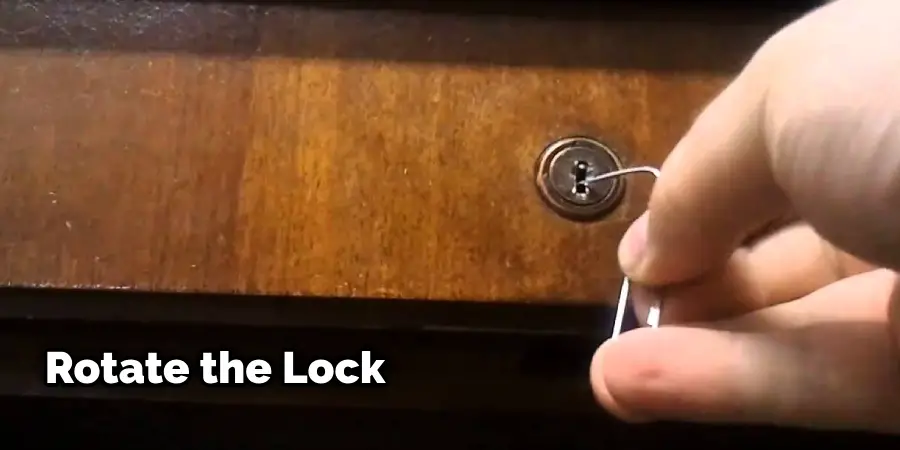
As you push up on each pin or wafer, try to rotate the lock. If you feel resistance or hear a clicking sound, it means that you have successfully aligned the internal components and the lock is ready to be rotated.
Step 8: Open the Drawer
Once the lock has been fully rotated, simply pull on the drawer handle to open it. Congratulations, you have successfully unlocked your drawer with a paper clip!
Troubleshooting and Tips
In this section, we will discuss some common issues you might encounter while trying to pick a lock with a paper clip and provide some tips to make the process smoother and more efficient. We will also address any lingering legal and ethical concerns.
A. Common Issues and How to Overcome Them
- The paper clip is too weak or keeps bending: If this happens, try to use a larger or stronger paper clip. Paper clips with thicker wire will be more durable and less prone to bending.
- Difficulty in identifying the pins or wafers: If you’re having trouble feeling the pins or wafers, try using a flashlight to illuminate the keyway.
- The lock won’t rotate even after pushing up the pins or wafers: This could mean that not all the pins or wafers are correctly aligned. Try to feel for any pins or wafers that haven’t been pushed up enough and adjust them accordingly.
B. Tips for a Smoother and More Efficient Lock-Picking
- Patience is key: Lock-picking can take some time, especially if you’re new to it. Don’t rush the process; instead, take your time feeling for the pins or wafers and aligning them correctly.
- Practice makes perfect: The more you practice, the better you’ll get at identifying the pins or wafers and knowing how much pressure to apply.
- Maintain your tools: Regularly check and straighten your paper clip to ensure it’s in good working order and ready to use when needed.
C. Addressing Legal and Ethical Concerns
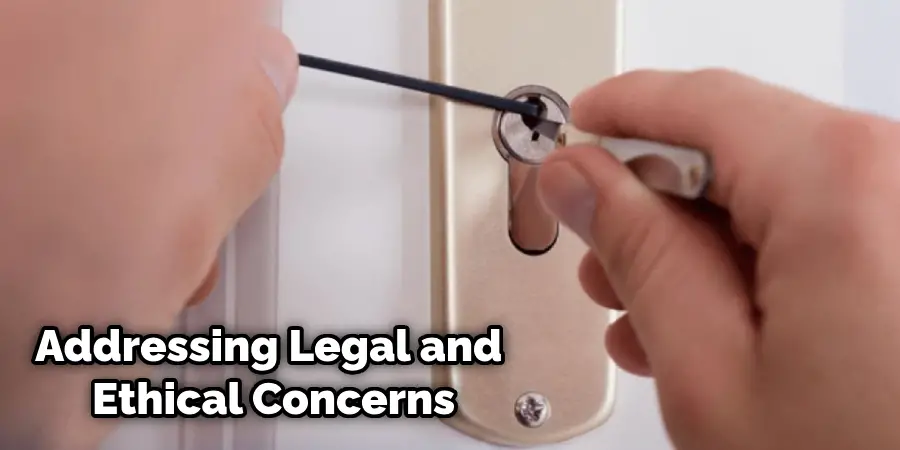
As mentioned earlier, you should only pick locks that you own or have explicit permission to open. Unauthorized lock-picking is illegal and unethical. Also, if you’re using these skills to help someone else, make sure they’re aware of what you’re doing and have given their consent. Always respect other people’s privacy and property.
Alternatives to Using a Paper Clip
While a paper clip is a handy and readily available tool for picking locks, it’s not the only option. In this section, we’ll explore other common household items that can also be used for this purpose.
A. Brief Overview of Other Common Household Items that Can be Used
- Bobby Pins: Like paper clips, bobby pins are small, flexible, and can be manipulated into various shapes, making them a popular tool for lock picking.
- Safety Pins: These function similarly to paper clips and bobby pins, but their sharp point may offer an advantage when trying to manipulate tiny lock components.
- Small Screwdrivers: Small flat-head screwdrivers can also be used to pick locks, especially those used for eyeglasses repair.
B. Pros and Cons of Different Methods
- Bobby Pins:
- Pros: Easy to use. More robust than paper clips.
- Cons: It may be too thick for some locks. It may break more easily.
- Safety Pins:
- Pros: Sharp points can help manipulate lock components.
- Cons: More difficult to handle safely due to the sharp point.
- Small Screwdrivers:
- Pros: Durable. Easy to handle.
- Cons: It may be too large for some keyways. It can damage the lock if not used carefully.
C. When to Seek Professional Help Instead
While these DIY methods can be helpful in a pinch, they’re not always the best solution. You should seek professional help if the lock is complex or valuable, if you’re unable to pick it up yourself, or if you’re uncomfortable with the process. A professional locksmith has the tools and expertise to open locks quickly and safely without causing damage. Remember that lock picking should always be done ethically and legally.
Legal and Ethical Considerations
As mentioned earlier, it’s essential only to pick locks that you own or have explicit permission to open. Unauthorized lock-picking is illegal and unethical. Additionally, while learning how to pick locks can be a useful skill in certain situations, it should not be used for malicious purposes. Always respect other people’s privacy and property.
If you’re unsure about the legality of picking a specific lock, it’s best to seek professional help or avoid attempting to pick it altogether. Finally, never force open a lock as this can cause damage and potentially result in legal consequences. Use these skills responsibly and with caution.
Conclusion
In conclusion, picking a lock with a paper clip is an easy and useful skill to have in case of emergencies. With some practice and patience, you can successfully open a lock without a key.
However, it’s crucial to use this skill ethically and legally while respecting other people’s privacy and property. Remember always to seek professional help when necessary and never attempt to force open a lock.
Stay safe and responsible! So go ahead and give it a try the next time you find yourself locked out of your drawer! Thanks for reading this article about how to open drawer lock with paper clip.

